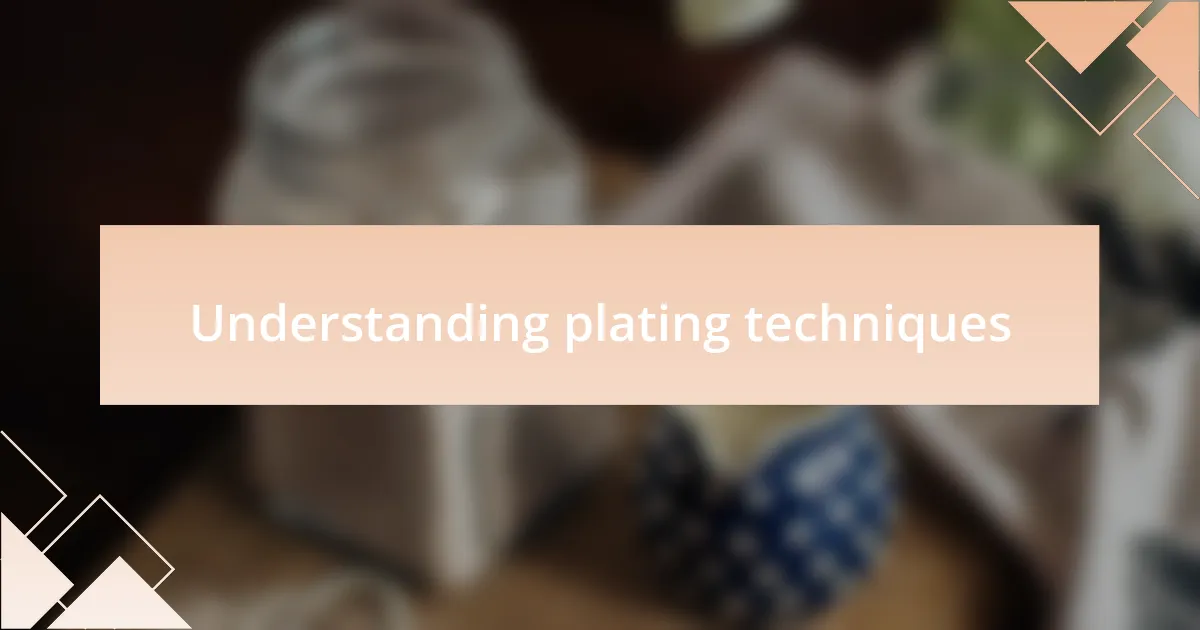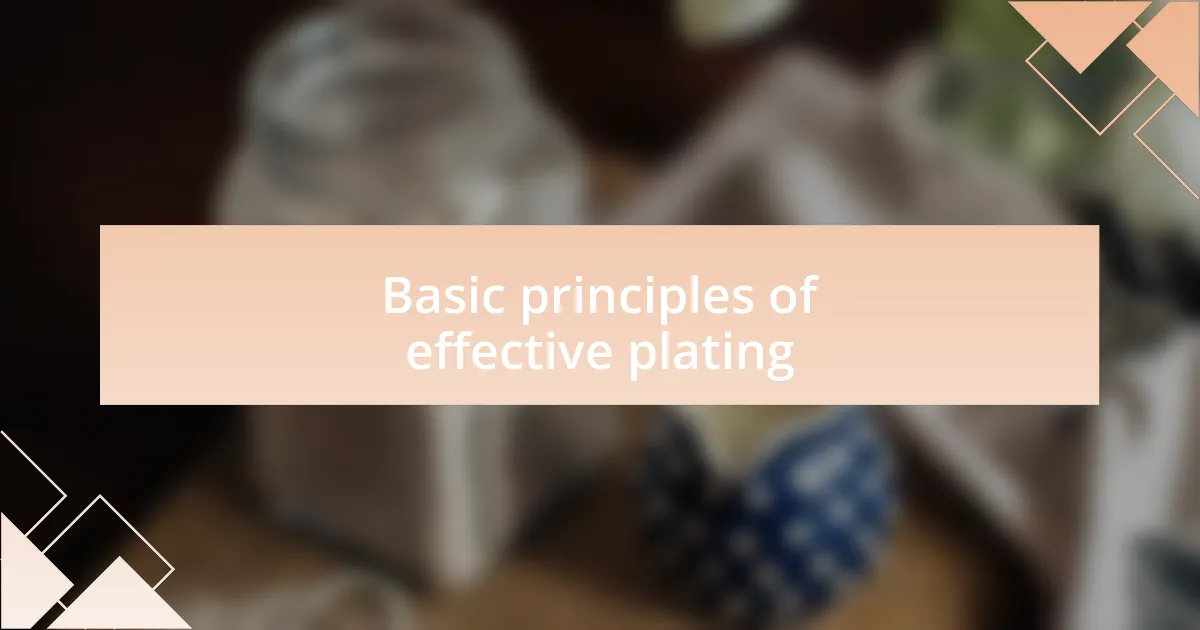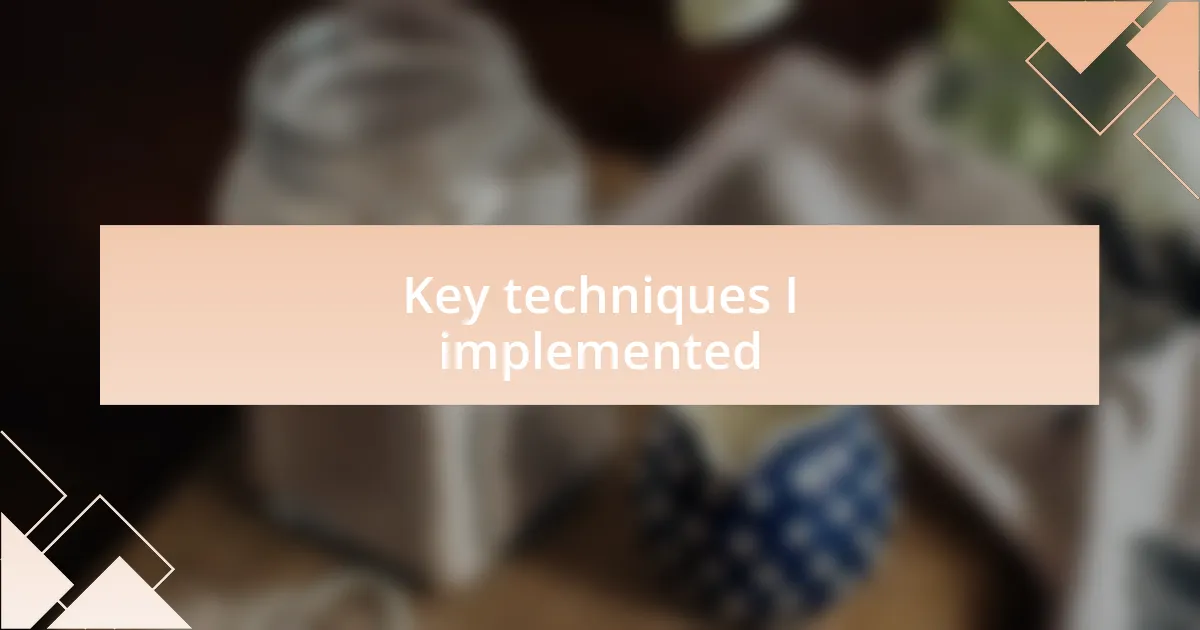Key takeaways:
- Effective plating involves balance, color contrast, and the use of height to enhance visual appeal and dining experience.
- Simplicity is key; leaving negative space on the plate allows each food element to shine and creates a more impactful presentation.
- The right tools, such as squeeze bottles and tweezers, can significantly improve precision and control in plating.
- Thoughtful garnishes should enhance not only the aesthetics but also the flavor and texture of a dish, elevating the overall experience.

Understanding plating techniques
Plating techniques are like the final brushstrokes on a painting; they can transform a simple dish into a culinary masterpiece. I recall the first time I experimented with height and layers in my plating. The thrill of watching my guests’ faces light up as they saw the artful presentation made me appreciate just how crucial this aspect of cooking is.
The way food is arranged on a plate can evoke emotions and even tell a story. I once prepared a dish by loosely placing ingredients in a way that mimicked the natural landscape, which not only impressed my diners but also sparked conversations about its inspiration. Have you ever realized that your favorite meals often have a visual charm that makes you want to dig in immediately?
Additionally, understanding balance and color contrast is essential for effective plating. I remember attending a workshop where we were taught to think of a plate as a canvas, balancing vibrant greens against rich reds and creamy whites. It struck me then how intentional choices in color and layout could elevate not just the taste, but also the overall dining experience. What colors resonate with you when you think about your favorite dishes?

Basic principles of effective plating
When it comes to effective plating, simplicity often reigns supreme. Early in my culinary journey, I found myself overloading plates with too many elements, thinking that a busy presentation would amaze diners. However, as I refined my techniques, I learned that leaving negative space on the plate can actually draw attention to the food itself, allowing each element to shine.
One principle I now swear by is the importance of height. I vividly recall a dish where I stacked ingredients to create a tower. The visual intrigue it sparked was instant—guests were captivated, and it encouraged them to dig in slowly, savoring the layers. Have you ever noticed how a dish filled with dimension seems more appetizing? That’s the magic of height in plating.
Moreover, I’m a firm believer in the element of garnish as a finishing touch. A sprig of fresh herb or a vibrant drizzle of sauce not only adds color but also invites curiosity. I often think back to a simple dessert I presented with a meticulously placed mint leaf that transformed the entire plate. It made me realize how a thoughtful garnish can resonate with the overall theme of the meal. What small touch have you added that made a significant difference in your plating?

Tools and materials for plating
When diving into the world of plating, the right tools can make all the difference. I remember the first time I used a squeeze bottle for sauces; the precision it brought was a game-changer. It transformed the way I composed my plates, allowing me to create elegant lines and designs that were once beyond my reach.
Additionally, various types of utensils, such as tweezers and offset spatulas, became my secret weapons. I discovered that using tweezers for delicate garnishes not only improved the aesthetics but also gave me a sense of control during busy service times. Have you ever struggled with a slippery herb that just wouldn’t sit as you desired? Having the right tool at your fingertips can elevate both your confidence and your dish.
Finally, the materials on the plates themselves shouldn’t be overlooked. I gravitate towards earthy ceramics and sleek glass because they enhance the food’s visual appeal. I once served a vibrant ratatouille on a rustic ceramic plate, and the contrast was stunning. It made me consider how the choice of material influences how we perceive the dish. What type of plate resonates with your style and enhances your food presentations?

My journey to improving plating
As I embarked on my journey to improve my plating, I realized that practice was key. One evening, while preparing a simple salad, I decided to challenge myself by using a large white plate instead of my usual smaller ones. The moment I arranged the vibrant greens and colorful tomatoes, I felt a wave of excitement. It was as if the plate had become a canvas, inviting me to express my creativity. How often do we let our surroundings influence our culinary presentations?
Throughout my plating experience, I often found myself rethinking the space around my food. I vividly recall a night in the kitchen where I plated a seared scallop dish. Initially, I stacked everything on top of each other, oblivious to the chaos it created. But then, inspired by a chef’s video, I embraced negative space. The transformation was immediate; the plate breathed, and the scallops emerged as stars rather than mere components. Have you ever stopped to consider how the arrangement can elevate an entire dish?
Another significant moment came when I attended a plating workshop hosted by a seasoned chef. The hands-on experience solidified many concepts for me. I learned that garnishes aren’t just pretty additions; they should enhance flavor and texture, too. When I added a touch of microgreens atop my dishes, it not only looked good but also added a fresh crunch that elevated the entire experience. Isn’t it incredible how thoughtful details can transform something ordinary into something extraordinary?

Key techniques I implemented
One key technique I implemented was segmenting my ingredients on the plate. I remember the first time I carefully placed each component of a dish separately instead of mixing everything together. The visual impact was striking; suddenly, each flavor had its own spotlight, inviting diners to explore one bite at a time. Have you ever noticed how this simple adjustment can create anticipation for the meal?
Another transformative approach involved using height in my plating. It was during a family gathering when I decided to stack layers of roasted vegetables and protein, creating a three-dimensional effect. Watching my loved ones’ eyes light up as they admired the towering creation was exhilarating. I realized then that height can bring drama to a dish. Have you tried elevating your presentations in this way?
Lastly, I embraced color harmony as an essential guideline. One evening, while preparing a vibrant beet salad, I focused on pairing the deep red beets with bright oranges and fresh greens. The colors were not just visually appealing; they also sparked joy and excitement. In culinary art, how crucial do you think it is to create an emotional response with color? For me, the answer is clear—it’s the heart of making a dish memorable.